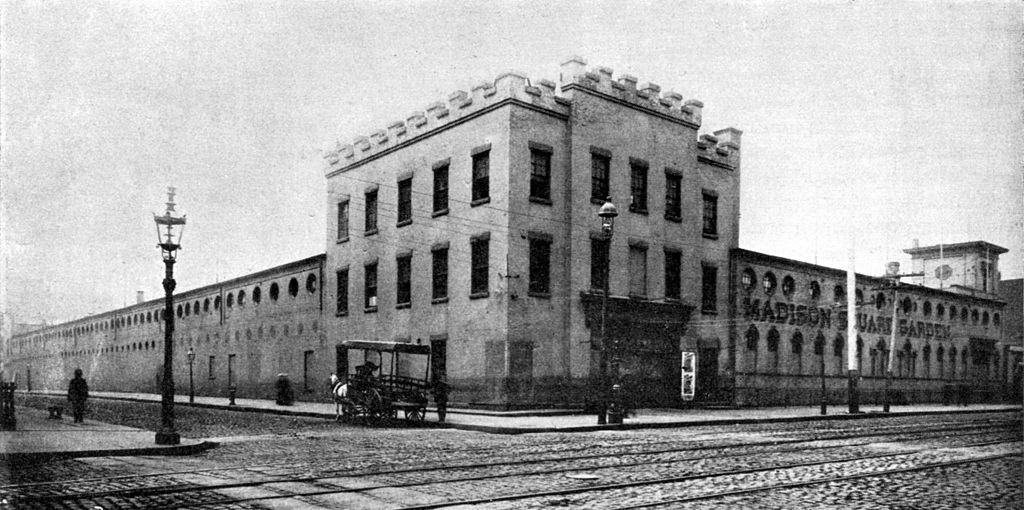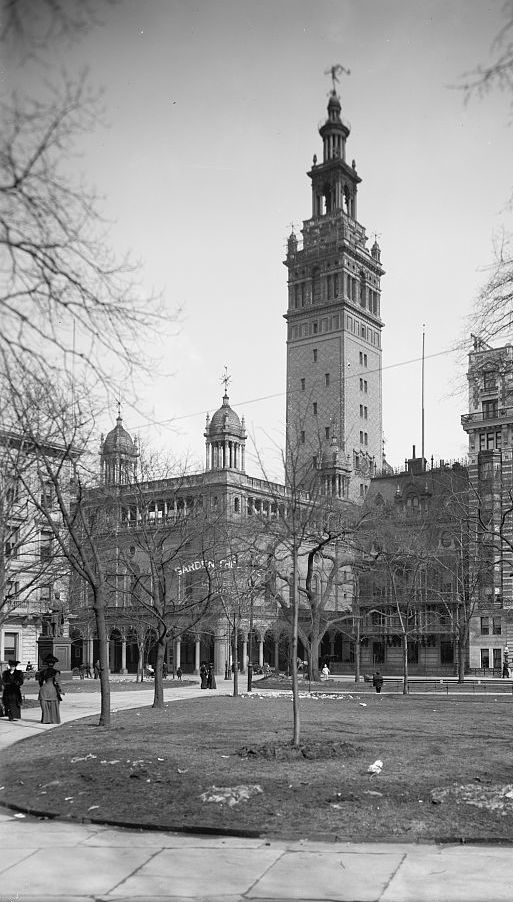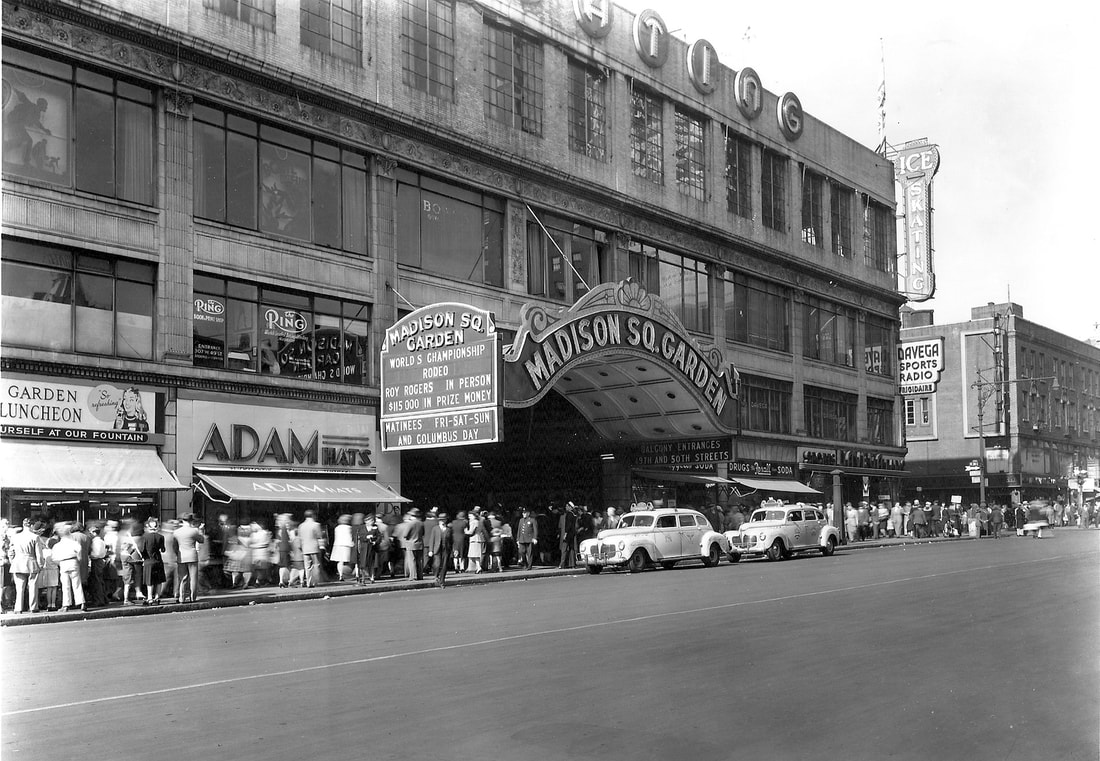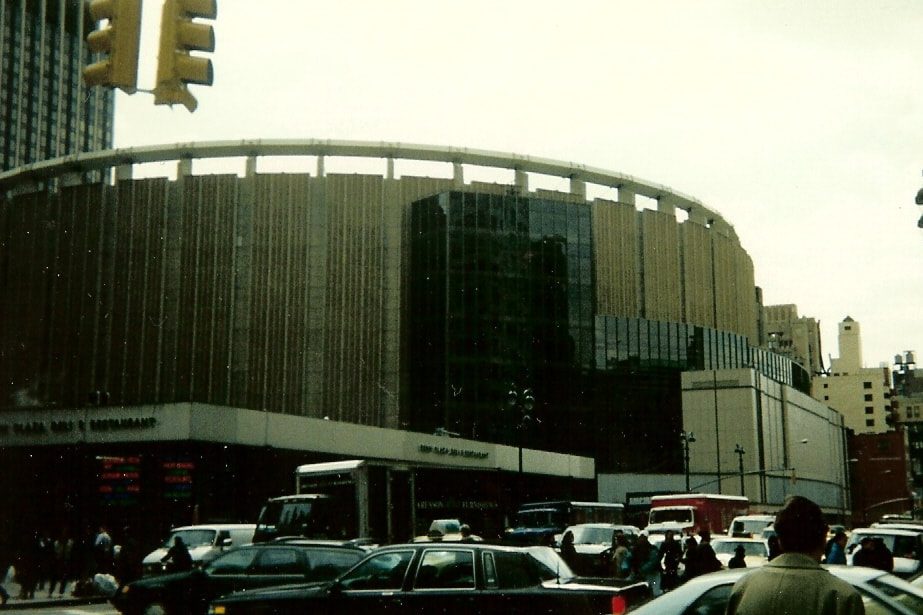|
By Laurie Lewis The name “Madison Square Garden” is somewhat misleading. The sports arena complex lacks the greenery that would merit the name “garden.” It’s not square. And it’s not on Madison Square, a park about two-thirds of a mile south of the arena. At least, the present Madison Square Garden isn’t there. The first two renditions actually were on Madison Square, at 26th Street and Madison Avenue. A train depot originally was at that location. When railroad magnate Cornelius “Commodore” Vanderbilt moved the station north in 1871 to what is now Grand Central, “the greatest showman” P. T. Barnum leased the space for his circus. He called the open-air facility the Hippodrome. In 1879, the Commodore’s grandson, William K. Vanderbilt, renamed the space Madison Square Garden. A variety of events occurred in the 10,000-seat arena, in addition to Barnum’s circus, including the first Westminster Kennel Club dog show and boxing matches. Grover Cleveland held a rally during his presidential campaign. The facility boasted a velodrome, a track for cycle racing, which was a big draw. The first Madison Square Garden (1879-1889) This Madison Square Garden was less than ideal because it had no roof, just a tent cover. Vanderbilt realized that a new structure designed specifically as a year-round sports and entertainment complex would be an improvement. He eventually sold the building and grounds to a group of well-heeled New Yorkers, including J. P. Morgan and Andrew Carnegie. They commissioned the leading architect of the day, Stanford White, who created the second Madison Square Garden, a Beaux-Art masterpiece. It opened in 1890 on the same site, within a year of the demolition of its predecessor. The 300-foot-plus tower of White’s elaborate Madison Square Garden made it the second-tallest building in New York at the time. Atop the tower was Augustus Saint-Gaudens’ gilded statue of Diana, goddess of the hunt, whose nudity so offended societal norms that she was covered by a cloth drape. (Little good that did. The cloth kept blowing away.) This Garden had a roof and multiple venues for a variety of entertainment, including a 12,000-person capacity amphitheater, 5,000-person arena, 3,000-seat concert hall, restaurants, and a rooftop garden for summer musicals. Events that took place here were similar to those held in the first Madison Square Garden, plus numerous concerts, the 1924 Democratic National Convention—and a famous assassination (see "Murder at the Garden," below). The second Madison Square Garden (1890-1925) The building to its right in the photograph, across 26th Street, was the childhood home of Jennie Jerome, the future mother of Winston Churchill. (The Jerome family had moved out before the first Madison Square Garden was their neighbor, and their former home had become a series of posh men’s clubs.) Despite its popularity, this Madison Square Garden struggled financially. The New York Life Insurance Company bought it in the early twentieth century and continued to lease it to Madison Square Garden until deciding to build its own office tower on the site. Stanford White’s masterpiece came down in 1925, replaced by the New York Life building, which still stands. At this point, Madison Square Garden left the Madison Square area, keeping its name but moving uptown to Eighth Avenue and 50th Street. This building was anything but elegant, but it was more or less adequate for spectator sports. The big attractions were boxing matches, Rangers hockey games, and Knicks basketball games. The circus continued to come to town here. The third Madison Square Garden also hosted political rallies and big bashes, the most famous being President John F. Kennedy’s 45th birthday party in 1962, where Marilyn Monroe offered a sultry birthday serenade. The third Madison Square Garden (1925-1968) A frequent complaint about the third Madison Square Garden was the poor sight lines. Many Garden-goers said that the 18,000 seats were not comfortable. So in the 1960s, when a unique opportunity arose, the sports facility moved again. That opportunity was the demolition of another masterpiece of Stanford White’s architectural firm, McKim, Mead, & White: Pennsylvania Station. The train tracks remained below ground, and a nondescript railroad concourse was above them. On the street level, between Seventh and Eighth Avenues and 31st and 33rd Streets, a huge cylindrical structure rose in 1968: the fourth (and present) Madison Square Garden. The fourth Madison Square Garden (1968-present) The opening day event for this facility was a salute to the U.S.O., with Bob Hope and Bing Crosby. Sports continue to be the mainstay of Madison Square Garden, which seats about 20,000 in the main arena. The home teams, the Knicks and the Rangers, have earned championship titles here. In 1971, the Garden was the scene of “the fight of the century” between Muhammad Ali and Joe Frazier. Music lovers have enjoyed concerts by Elvis Presley, John Lennon, Elton John, Billy Joel, and many other pop idols. The arena has also hosted political conventions and visits by two popes: John Paul II in 1979 and Francis in 2015. A separate theater is under the arena. So while the location has changed, the name and the mission of the arena have remained the same for more than 140 years. Madison Square Garden is and always has been one of New York City’s premier venues for sporting events, popular entertainment, and large-scale gatherings. Murder at the Garden Stanford White, the architect of the second Madison Square Garden, was the Bill Cosby or Harvey Weinstein of an earlier era. White took advantage of his fame and power to have his way with women. He seduced an actress and model named Evelyn Nesbitt when she was just a teenager, and they continued to have a sexual relationship for some time. But when she married Harry Thaw in 1905, Nesbitt and the much older White were no longer involved. That didn’t temper Thaw’s hatred of the architect. On June 25, 1906, White was enjoying a performance on the rooftop of his Madison Square Garden when Harry Thaw fatally shot him in view of plenty of witnesses. Thaw’s trial, dubbed “the trial of the century” (as was the O. J. Simpson trial at the end of the same century), kept the tabloids busy for years. January Tours Most Take a Walk New York tours cover 1 to 2 miles, last 2 to 2½ hours, and cost $25 per person. Advance registration is required. To register and to learn the meeting place, email the guide ([email protected]). Please arrive a little before the start time. Tours are cancelled if nobody has registered or if the weather is extreme; if in doubt, call or text Laurie (917-306-2868). Central Park: Highlights of the Southern Half In the popular southern half of Central Park, you’ll recognize some of the most filmed and photographed sights in New York, including Strawberry Fields, the Sheep Meadow, and Bethesda Terrace. The park beckons in all kinds of weather. In winter, you clearly see some design elements that are hard to detect in other seasons through the foliage and visiting crowds. Take a walk through the southern half of Central Park on Sunday, January 12, at 1 PM. We’ll cover as much ground as weather permits. Please email the guide ([email protected]) to register and to learn the meeting location. Greenwich Village: In the Footsteps of Writers Many writers and other creative people have called Greenwich Village home. On this tour, you’ll meander through charming Village streets and peek into hidden cul-de-sacs as you learn where some famous writers—including Edna St. Vincent Millay, e.e. cummings, and Edward Albee—lived. Maybe the Village aura will spark your own creativity! Laurie gives this tour on Sunday, January 19 at 1 PM. To reserve a place and to learn the meeting location, email her at [email protected]. Hidden Treasures of the Financial District Walking through the canyons of Wall Street, you can easily miss gems hidden in plain sight, including relics of the Dutch and English colonial periods and park-like oases. Discover these secrets while seeing major attractions like the New York Stock Exchange and the Charging Bull statue. You’ll realize that the Financial District has a lot more going for it than stock trades and megadeals. Laurie offers this tour on Saturday, January 25, at 1 PM. To reserve a spot on the tour and to learn the meeting location, email her at [email protected].
January Tours
|
Archives
April 2024
|





